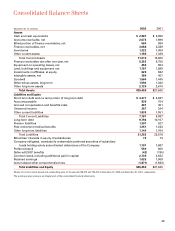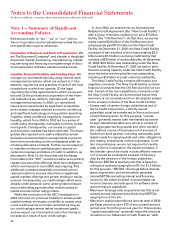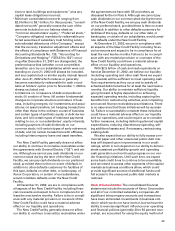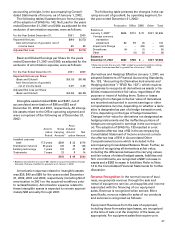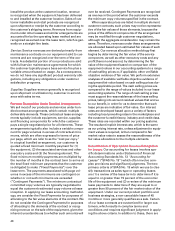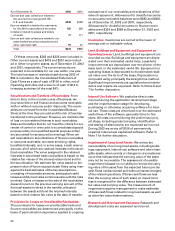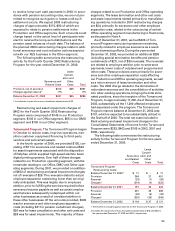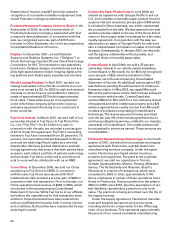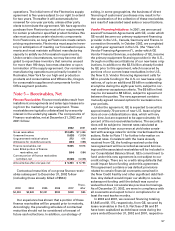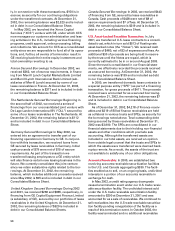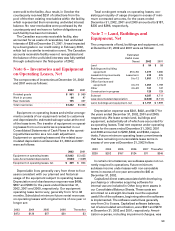Xerox 2002 Annual Report Download - page 51
Download and view the complete annual report
Please find page 51 of the 2002 Xerox annual report below. You can navigate through the pages in the report by either clicking on the pages listed below, or by using the keyword search tool below to find specific information within the annual report.
49
also other important criteria that are required to be
assessed, including whether collectibility of the lease
payments is reasonably predictable and whether
there are important uncertainties related to costs that
we have yet to incur with respect to the lease. In our
opinion, our sales-type lease portfolios contain only
normal credit and collection risks and have no impor-
tant uncertainties with respect to future costs. Our
leases in our Latin America operations have historical-
ly been recorded as operating leases since a majority
of these leases are terminated significantly prior to
the expiration of the contractual lease term. Specific-
ally, because we generally do not collect the receiv-
able from the initial transaction upon termination
or during any subsequent lease term, the recover-
ability of the lease investment is deemed not to be
predictable at lease inception. We continue to evalu-
ate economic, business and political conditions in the
Latin American region to determine if certain leases
will qualify as sales-type leases in future periods.
The critical estimates and judgments that we consid-
er with respect to our lease accounting are the deter-
mination of the economic life and the fair value
of equipment, including the residual value. Those esti-
mates are based upon historical experience with all our
products. For purposes of estimating the economic life,
we consider the most objective measure of historical
experience to be the original contract term, since most
equipment is returned by lessees at or near the end of
the contracted term. The estimated economic life of
most of our products is five years since this represents
the most frequent contractual lease term for our princi-
pal products and only a small percentage of our leases
have original terms longer than five years. We believe
that this is representative of the period during which
the equipment is expected to be economically usable,
with normal service, for the purpose for which it is
intended. We continually evaluate the economic life of
both existing and newly introduced products for pur-
poses of this determination. Residual values are estab-
lished at lease inception using estimates of fair value at
the end of the lease term. Our residual values are
established with due consideration to forecasted sup-
ply and demand for our various products, product
retirement and future product launch plans, end of
lease customer behavior, remanufacturing strategies,
used equipment markets if any, competition and tech-
nological changes.
The vast majority of our leases that qualify as
sales-type are non-cancelable and include cancella-
tion penalties approximately equal to the full value of
the leased equipment. Certain of our governmental
contracts may have cancellation provisions or renew-
al clauses that are required by law, such as (1) those
dependant on fiscal funding outside of a governmen-
tal unit’s control, (2) those that can be cancelled if
deemed in the taxpayer’s best interest or (3) those
that must be renewed each fiscal year, given limita-
tions that may exist on entering multi-year contracts
that are imposed by statute. In these circumstances
and in accordance with the relevant accounting litera-
ture, we carefully evaluate these contracts to assess
whether cancellation is remote or the renewal option
is reasonably assured of exercise because of the
existence of substantive economic penalties for the
customer’s failure to renew. Certain of our commer-
cial contracts for multiple units of equipment may
include clauses that allow for a return of a limited
portion of such equipment (up to 10 percent of the
value of equipment). These return clauses are only
available in very limited circumstances as negotiated
at lease inception. We account for our estimate of
equipment to be returned under these contracts as
operating leases.
Aside from the initial lease of equipment to our
customers, we may enter subsequent transactions
with the same customer whereby we extend the term.
We evaluate the classification of lease extensions of
sales-type leases using the originally determined eco-
nomic life for each product. There may be instances
where we have lease extensions for periods that are
within the original economic life of the equipment.
These are accounted for as sales-type leases only
when the extensions occur in the last three months of
the lease term and they otherwise meet the appropri-
ate criteria of SFAS No. 13. All other lease extensions
of this type are accounted for as direct financing leas-
es. We generally account for lease extensions that go
beyond the economic life as operating leases because
of important uncertainties as to the amount of servic-
ing and repair costs that we may incur.
Cash and Cash Equivalents: Cash and cash
equivalents consist of cash on hand and investments
with original maturities of three months or less.
Restricted Cash and Investments: Due to our credit
ratings, many of our derivative contracts and several
other material contracts require us to post cash collat-
eral or maintain minimum cash balances in escrow.
These cash amounts are reported in our Consolidated
Balance Sheets within Other current assets or Other
long-term assets, depending on when the cash will be
contractually released. At December 31, 2002 and
2001, such restricted cash amounts were as follows:


